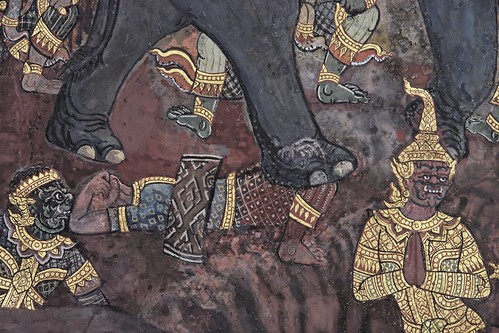The above link will play a video of the introduction. You can download the speech (in Japanese) in its entirety here (Thanks to Curzon for optimizing the audio quality):
Part 1: Introduction
Part 2: Slide Show
Part 3: Question-and-answer Session
Summary
On Monday, I attended a speech given by author/businessman/historical preservation activist Alex Kerr co-sponsored by the Japan Foundation and the Japanese Language Group of the Thailand National Museum Volunteer Guides. For the modest fee of 250 baht (about 600 yen/US$6), the crowd, a packed house consisting mostly of middle-aged and elderly Japanese women and a few elderly Japanese men — i.e. the type of people who have the free time to attend a seminar on a Monday morning — got to hear the veteran promoter of Japanese traditional arts outline the arguments made in his two popular books, Lost Japan and Dogs and Demons. Though born in Maryland, Kerr spent the majority of his adult life in Japan and therefore had little trouble giving the speech in Japanese.
He started out by reflecting on his first experiences with Japan. He came to the country in 1964 when his father, a career officer in the US Navy, was stationed in Yokohama. He spoke proudly of how his arrival coincided with the historic Tokyo summer Olympics, and reflected on the excitement of that time. He mentioned that the atmosphere of excitement, rising living standards, economic growth, and opportunity closely resembles the national mood of Thailand now. He became enamored of Japanese houses by accompanying his mother on monthly visits to neighborhood houses in her capacity as a member of a Japan wives’ club.
He went on to describe the motivation for him to write Lost Japan and Dogs and Demons, the latter a book that he took 8 years to research. Essentially, he could not bring himself to write nice things about how beautiful Japan was when ugliness stared him in the face. The destruction of Japan’s beautiful landscapes and houses by a development-minded bureaucracy were deplorable and wanted to do something about it.
Then, to give people an idea of the destruction he was talking about, he spent the rest of his speech presenting a slideshow along with his own running commentary. The slideshow was kind of like a live version of the Dogs and Demons book – half of his presentation was spent introducing scenes of the concretization of Japan in places like the Iya valley that Kerr calls his second home, mostly using photos by famous Japanese photographer Toshio Shibata (some of his works can be found here). He spent a good amount of time railing against the ruining of Kyoto’s historical heritage – destroyed historic buildings, the godawful Kyoto Tower, electric lines outside Sanjusangendo. He had plenty of outrage leftover to decry the massive “monument” museums and event halls that have all but bankrupted small villages, the ugly exposed power lines, the cookie-cutter houses from the Sekisui House company, and all the other supposedly tasteless development in Japan that disrupt Kerr’s beloved Japanese landscapes. These monstrosities are caused in his words by a bureaucracy “on auto-pilot.” This is a well-known and well-traveled argument, and Kerr has not changed his tune a bit since the book was released.. If you are not familiar with the gist of the Dogs and Demons argument, I recommend taking a look at the NY Times review of the book that is available on Kerr’s website. Still, he believes that the Koizumi years, during which the Japan’s management companies were privatized and recognition of the role of non-profit organizations became more widespread, were an era in which “consciousness started changing” with regard to the old system.
Continue reading Adamu Reports: Alex Kerr Speech at Japan Foundation, Bangkok November 20, 2006








